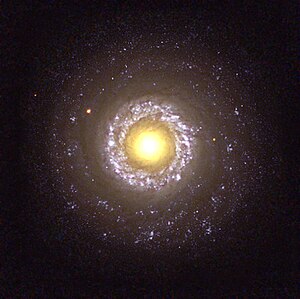NGC 7742
| Galaxy NGC 7742 |
|
|---|---|

|
|
| Detail of NGC 7742 captured by the Hubble Space Telescope |
|
| AladinLite | |
| Constellation | Pegasus |
|
Position equinox : J2000.0 , epoch : J2000.0 |
|
| Right ascension | 23 h 44 m 15.86 s |
| declination | + 10 ° 46 ′ 01 ″ |
| Appearance | |
| Morphological type | SA (r) b; |
| Brightness (visual) | 11.6 mag |
| Brightness (B-band) | 12.4 mag |
| Angular expansion | 1.7 ′ × 1.7 ′ |
| Surface brightness | 12.6 mag / arcmin² |
| Physical data | |
| Redshift | 0.005547 ± 0.000003 |
| Radial velocity | 1663 ± 1 km / s |
|
Stroke distance v rad / H 0 |
(81 ± 6) · 10 6 ly (24.8 ± 1.7) Mpc |
| diameter | 36,000 ly |
| history | |
| discovery | Wilhelm Herschel |
| Discovery date | October 18, 1784 |
| Catalog names | |
| NGC 7742 • UGC 12760 • PGC 72260 • CGCG 432-023 • MCG + 02-60-10 • IRAS 23417 + 1029 • KUG 2341 + 104 • 2MASX J23441571 + 1046015 • GC 5005 • H II 255 • h 2264 • | |
NGC 7742 is a galaxy in the constellation Pegasus .
Due to the redshift , their distance can be estimated to be around 80 million light years . With a diameter of 36,000 light years, it is relatively small. Their apparent magnitude is 11.6 mag, i.e. H. you need very good instruments for observation. It is a Seyfert galaxy of type 2. Because of its appearance it is also called the “fried egg galaxy”. It has the following structure (from the inside out):
- Scientists suspect a massive black hole in the middle of this galaxy .
- Around it is a very bright core and a dust belt about 2000 light years apart.
- In the following bluish region (approx. 3200 light years) a lot of stars are formed.
- This is followed by another dust belt with a much lower density than the first.
- Only outside the second dust belt are there spiral arms , as are common in spiral galaxies .
NGC 7742 has what is known as an " active core "; H. the black hole accretes (“consumes”) mass from its surroundings. These cores are characterized by an extreme brightness, which can easily reach ten thousand times that of a normal core. There may be a ring-shaped, unobservable accumulation of dust around the black hole. Therefore radiation can only escape in the axial direction and ionize the surrounding gas . That would mean that NGC 7742 probably only appears so bright because we happen to be exactly on this axis.
discovery
The galaxy NGC 7742 was discovered on October 18, 1784 by the German-British astronomer Wilhelm Herschel .
Web links
- Hubble Space Telescope
- Black extinguishers - symbiosis with host galaxy discovered. In: astronews.com. July 17, 2003.
- Spiral Galaxy NGC 7742 - Astronomy Picture of the Day from July 26, 2003.
